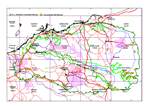Click on images
to enlarge



Photographer: M.W. McDonald

Photographer: M.W. McDonald

Photographer: B.R. Maslin

Photographer: B.R. Maslin
, cult. Nullagine, BRM 18 July 2000, ORIGINAL SCAN_sml.jpg)
Photographer: B.R. Maslin
, Karratha Primary School, BRM 17 Oct 1984, ORIGINAL_sml.jpg)
Photographer: B.R. Maslin

Photographer: M.W. McDonald
, AA Mitchell PRP811, lab photo by Fiona McCallum ADJUSTED_sml.jpg)
Seed from one herbarium voucher. Scale in mm. Photographer: F. McCallum.
Botanical name
Acacia wanyu Tindale, Contr. New South Wales Natl Herb. 4: 270, pl. 24 (1972)
Common name
Wanyu (preferred common name) and Silver-leaf Mulga
Aboriginal name
Murruturu or Yirritiri (Kurrama), Wurlany (Thalanyji) and Wayartany (Nyangumarta)
Description
Shrubs or shrubby trees 1-4 (-5) m tall, young shrubs multi-stemmed (main stems sub-straight and not horizontally branched) and rounded or obconic with sub-rounded crowns, mature plants may be single-stemmed with a rather gnarled growth habit, these have rather crooked, ±horizontally spreading branches and dense, silvery light green crowns spreading to 2-5 m across. Bark grey, smooth on branches, fissured towards base of mature stems. Branchlets sericeous with ±silky, appressed, silvery white hairs at apices, becoming glabrous with age. New shoots pale yellowish green with a silvery sheen. Phyllodes filiform, slender and terete, 5-18 cm long, 0.8-1.3 mm in diameter, thin and flexible (not rigid), erect, straight to incurved, densely sericeous as on branchlets, light silvery green or grey-green to bluish green; parallel longitudinal nerves numerous, fine and close together; apex acute but not at all spiny. Inflorescences simple, 1 or 2 within the axil of the phyllodes; peduncles 3-6 (-10) mm long, sericeous; spikes about 10-30 mm long, light golden, flowers not densely arranged along the receptacle. Flowers 5-merous; sepals 1/3 as long as petals, united. Pods pendulous, ±moniliform, 6.5-18 cm long, thick (6-10 mm in diameter), woody, smooth when young but becoming coarsely wrinkled with age (at least when dry), straight or slightly curved, silvery sericeous to glabrous, brown to yellowish at maturity. Seeds longitudinal in pods, broadly ellipsoid, 6-9 mm long, not shiny, brown.
Characteristic features
Attractive shrubs or small trees (ultimately attaining a somewhat gnarled growth form), with a dense, light green crown. New shoots pale yellowish green. Phyllodes long (5-18 cm), terete, slender, neither rigid nor pungent-pointed, sericeous with a distinctive silvery sheen, finely multi-nerved. Spikes light golden, flowers not densely arranged along the receptacle; peduncles short (mostly 3-6 mm). Pods moniliform, large (6.5-18 cm x 6-10 mm), pendulous, woody, coarsely wrinkled, brown to yellowish.
Distribution and ecology
Endemic in Western Australia where it occurs from near Pannawonica in the Pilbara south to Pingandie Station in the Ashburton district, then eastwards along the southern areas of the Pilbara to the vicinity of Rudall River in the Great Sandy Desert; there is an outlying population on Winderie Station, east of Shark Bay. Acacia wanyu is not especially common in the Pilbara but it ranges over quite a wide area and can form extensive populations in the places where it grows. It extends from Nanutarra and the Fortescue Roadhouse in the west to Balfour Downs Station in the east; there are outliers both to the south and east of Marble Bar. It commonly occurs along creeks and drainage lines, in often stony clay, loam or sandy loam (pH 6.5-7.5), often in association with Mulga and other Acacia species (e.g. A. synchronicia and A. coriacea subsp. pendens) in low scrub to tall shrubland on plains and similar areas of low relief.
Flowering and fruiting period
Flowering appears to be erratic and is probably dependent upon timing and intensity of rainfall. Pilbara flowering specimens have been recorded in February, April-May, July and October. Pods with mature seed have been collected between August and December.
Affinities
The delicate foliage of A. wanyu can also be similar to that of A. tenuissima , a species that is readily distinguished by its glabrous phyllodes and smaller, somewhat papery pods. Acacia wanyu is very closely allied to A. cuthbertsonii subsp. linearis (which does not occur in the Pilbara) which is distinguished by its normally compressed, sub-rigid phyllodes and non-moniliform pods. May sometimes be confused with shrubby specimens of A. orthocarpa or A. arida from which it can be readily distinguished by pod shape and the colour and length of the phyllodes.
Notes
Plants of this species are attractive and make fine horticultural specimens. They are characterized by having dense, bushy, light green crowns and pale yellowish green new shoots; the phyllodes produce a distinctive silvery sheen, an effect that is especially apparent when the foliage moves in a breeze. The breeze passing through the fine foliage makes a soothing hissing sound, like that produced by A. sibilans (and other fine-foliaged acacias) and species of sheoak. When in flower A. wanyu produces numerous, light golden spikes with often some of the large pendulous pods persisting from the previous year. Older plants have a somewhat gnarled growth form and are similarly attractive.
In the early days of the Pilbara pastoral industry the bushy branches were also used to fashion sheep yards.
The seeds of Wanyu were not eaten by Pilbara aboriginal people, however, the branches make good shade and the wood was used to make boomerangs. The phyllodes were also burnt and the resulting ash mixed with tobacco to make a chewing quid.
Conservation status
Not considered rare or endangered.
Origin of name
The botanical name is derived from the vernacular name under which this species was commonly known (Tindale 1972). In Western Australia the common name 'wanyu' was formerly applied to the unrelated species A. ramulosa.
References
Tindale, M.D. (1972). Notes on Australian Taxa of Acacia No. 3. Contributions from the New South Wales National Herbarium 4(5): 269-274.
